Today it is often believed that the Holocaust was the product of one man's madness. However, genocide could not take place without generating a collective animosity towards Jews. What fears were in the Germans before the war and how did Nazi propaganda take advantage of them? And what did Hitler himself really think about Jews?
Before the war, Germany was inhabited by about half a million Jews, who constituted only one percent of the German population. Moreover, they were distinguished primarily by the degree of assimilation with the local population. As Timothy Snyder recalls in his latest book, "Black Earth ." The Holocaust as a warning ”:
A large number of them have assimilated into German society both linguistically and culturally. In fact, German high culture at the beginning of the 20th century [...] was largely the work of the Jews . Most Germans did not see them in their daily life and were not particularly skilled at distinguishing Jews from non-Jews.
So how did the Jews from uncomfortable neighbors become subhumans who had to be exterminated?
Patriots or cowards?
The outbreak of World War I in 1914, although it was not announced at first, became the germ of anti-Semitism. Failures at the front and increased arms needs sowed ferment among German artisans, farmers and shopkeepers who fell victim to wartime capitalism.
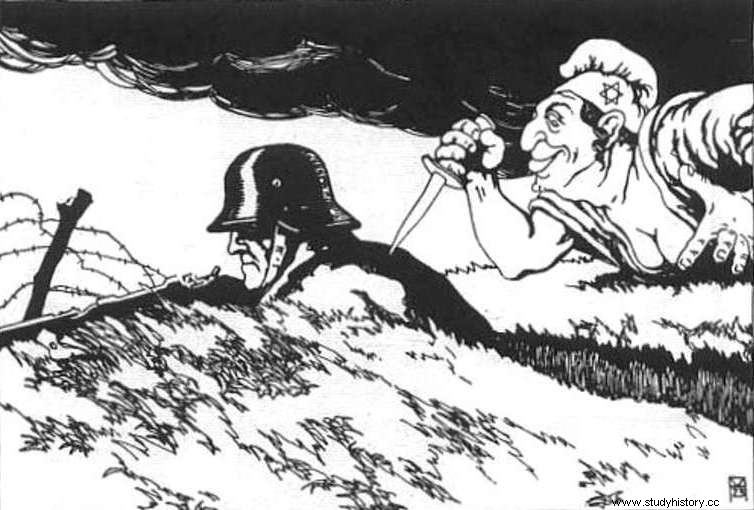
The myth of the "stab in the back" allegedly inflicted on Germany by the Jews became one of the foundations of Hitler's theories (source:public domain).
Questions have begun about who is shedding blood for the motherland and who is evading the fight. This is how the census of Jews conducted by the Ministry of War in 1916 took place.
It was racial - allegations of cowardice, which were supposed to be ethnically determined , were investigated . However, it soon turned out that patriots are not difficult to find among the Jews - over 12,000 Jewish soldiers fought for Germany during the Great War.
The census, however, sowed the seeds of hatred and jealousy. This was especially true of Jewish entrepreneurs making coconuts in the war, such as the leading supplier of raw materials for the German military, Walter Rathenau. This gave the illusion of wealth to the Jews at a time when the average Berliner had nothing to put in a pot.

The article was based, inter alia, on the book by Timothy Snyder entitled "Black ground. The Holocaust as a warning ”(Znak Horyzont 2015).
Knife in the back
The end of the war in 1918 only intensified these moods. The search for a scapegoat has begun. The blame for the defeat of Germany was blamed on the Jews, accused of stabbing a knife "in the German back", which were allegedly engaged in sabotage in the field of politics and economy. Timothy Snyder also writes about the sense of injustice that touched most Germans, including Adolf Hitler:
His interpretation of the outcome of the conflict fell outside the scope of normal German nationalism, and his response to failure resembled only the superficial resentment of the loss of territories. From Hitler's point of view, the defeat of Germany indicated that the structure of the world had been distorted and was unquestionable evidence that nature was ruled by Jews . […]
The feeling that Germany deserved to win was obviously common, and not only among militarists or extremists. The greatest of German writers, the later opponent of Hitler, Tomasz Mann, spoke of the German "right to domination and to participate in governing the world".
Soon all German society was going to infuse these ideas.
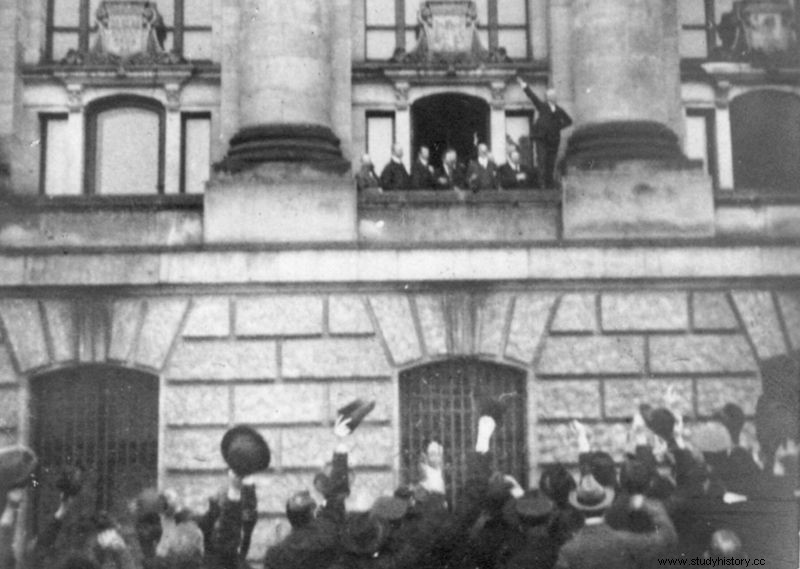
The establishment of the Weimar Republic was for many German nationalists a "stab in the back" inflicted by the Social Democrats, among whom, as was emphasized, there were many Jews. In the photo, Philip Scheidemann proclaims the republic on November 9, 1918 from the window of the chancellor's office (source:public domain).
The first pogroms
A "stab in the back" inflicted by the Social Democrats was for many Germans, especially those with nationalist inclinations, the establishment of the Weimar Republic, supported by the Jewish minority.
Her participation in building a new state - of Jewish origin were among others chancellor and minister of the interior and co-author of the Weimar constitution - was an argument for identifying them with the new power.
Check where to buy 'Black Earth. The Holocaust as a warning ”:
It is difficult to say to what extent the average Schmitt was interested in Judenfrage (Jewish question). At the time, most Germans had yet to bother with one percent of the population, but anti-Semitic sentiment was nevertheless recorded. In Swabia it was reported that you still hear people around that our government is selling us to Jews . Even before the Hitler era, there were several anti-Jewish riots, incl. in Berlin and Munich, where several people were killed.
It's just self-defense
Soon, Jews were accused of supporting virtually every form of power, but it was the myth of Judeo-Bolshevism that fueled the most strongly the German imagination. The connection of the Jews with the revolutionaries was nothing special at that time.
For example, British officials also believed that the Bolsheviks were entirely organized and led by Jews . The chief rabbi of Moscow, observing anti-Semitic moods in Europe, even said that the Trotskyites caused the revolutions, but it was the Bronsteins who had to pay for them .
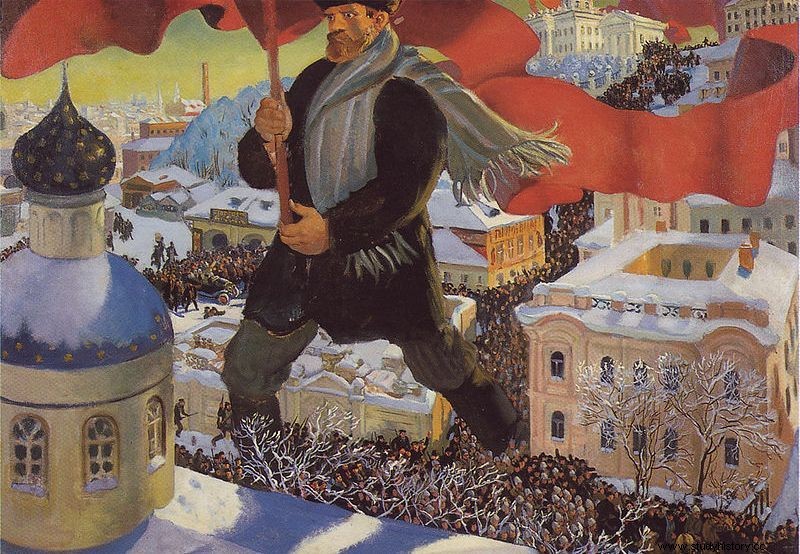
In the interwar period, the association of Jews with the Bolshevik revolution in Russia was common not only in Germany (source:public domain).
The specter of the Bolshevik dictatorship terrified not only the far right, but it was she who, along with the development of the National Socialist party, began to have a monopoly on the preaching of stereotypes about the Judeo-Communism and international conspiracy. Writes about it, among others Timothy Snyder:
"In exercising control in Soviet Russia, international Jewry created Bolshevism tries to infect the peoples of the world with its rot," wrote [Hitler]. […] Germany could become a global power by eliminating East European Jews and dusting their supposed Soviet stronghold. It was only about self-defense, in his opinion ...
More and more Jews were depicted with a sickle and hammer emblem. This image was to be maintained for several dozen years, not only in Germany.
Your own or a stranger?
Lowering the standard of living and rising unemployment to 6 million people after the economic crisis of the late 1920s made Germany susceptible to the propaganda of the NSDAP - a party that was slowly coming to power.
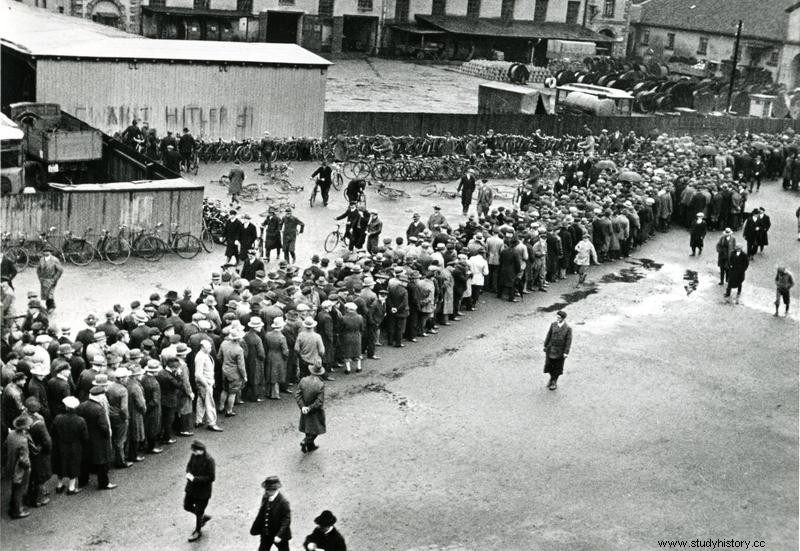
The dramatic deterioration in the living conditions of millions of Germans as a result of the Great Depression created fertile ground for the anti-Semitic slogans of Hitler and his supporters. In the photo from 1930, Hanoverian unemployed queuing to the employment office (source:public domain).
The implementation of her program was intended to ensure prosperity, and this encouraged people to follow her activities. And also to pay attention to its other postulates, including those concerning Jews. More and more often, despite the high degree of assimilation, people began to talk about the separateness of Jews. Hitler himself emphasized this in his memoirs from his stay in Austria:
When I was walking around town one time, I encountered a creature with black sideburns in a long straitjacket. My first thought was whether it was a Jew. They looked completely different in Linz. I watched the man cautiously, but the more I stared at him and examined his features, the more the question came to me:is this a German?
Hundreds of Germans started asking themselves similar questions. The separateness of the Jews was to confirm the thesis that they could not belong to Volk - the German nation. The Nazi propaganda, however, went a step further.
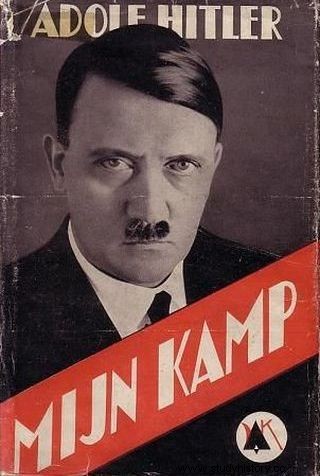
"Mein Kampf", it was this book that became one of the pillars of Nazi anti-Semitism (source:public domain).
The Jews were not a religious or ethnic group for them, but a race that was the opposite of the true Germans - the Aryans. They were also increasingly seen as conspiring elites to prevent Hitler from coming to power.
The embodiment of evil or is it good?
The anti-Semitic propaganda machine has started for good with the best-selling sale of Hitler's "Protocols of the Elders of Zion" and "Mein Kampf", as well as articles of the weekly "Der Stürmer". They used stereotypes well known from the nineteenth-century beliefs about the personification of demonic power by Jews.
Since then, they have been presented mainly as the embodiment of the devil, a symbol of absolute evil. They were to be like parasites and microbes that infect a healthy organism . They were also depicted as incapable of creating their own culture and creating a state, which was to prove the existence of an international conspiracy to take over the world.
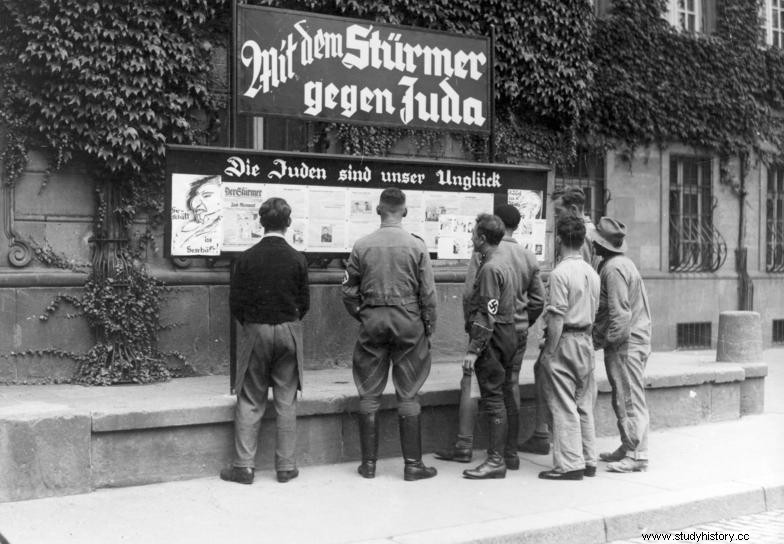
The weekly "Der Stürmer" was one of the main tools of the Nazis in spreading anti-Semitic slogans. In the photo from 1933, the inhabitants of Worms read "Stürmer" (source:Bundesarchiv; lic. CC ASA 3.0).
In "Mein Kampf", which became the bible of the Nazis, confirmation of these theses was found. Nevertheless, it seems that Hitler's message is simplifying today, as Timothy Snyder shows in Black Earth. The historian, who carefully read the chaotic reflections of the Fuhrer, emphasizes that the Jews were for the German dictator not so much a symbol of evil as, in fact, of good:
Hitler did not claim - like many others - that humans are essentially good, but were corrupted by a civilization that was too Jewish in nature. Instead, he believed that humans are animals and that any ethical consideration is a sign of "Jewish corruption."
Moreover, the Jews were to be the ones who destroyed Eden by bringing the knowledge of good and evil. Hitler claimed that the war with them was to change the living conditions on Earth and restore the natural order of the world. If the Jew wins, his crown will be the mourning wreath of the human race .

The article was based, inter alia, on the book by Timothy Snyder entitled ""Black ground. The Holocaust as a warning ”(Znak Horyzont 2015).
These theses were especially attractive to the Germans who, in their own opinion, were predestined to save the world of this threat. So there was nothing else to do but put the idea into practice. It became possible after Hitler came to power in 1933.Bibliography:
- Michael Burleigh, Third Reich. New story , Znak, Kraków 2010.
- Peter Fritzsche, Life and Death in the Third Reich , Publishing House of the Jagiellonian University, Kraków 2010.
- Timothy Snyder, Black Earth. The Holocaust as a warning, Znak Horyzont, Krakow 2015.
- Selection of sources for teaching about the extermination of Jews in occupied Poland , selection and development by a team led by Alina Skibińska and Robert Szuchta, Association Center for Research on the Extermination of Jews, Warsaw 2010.
